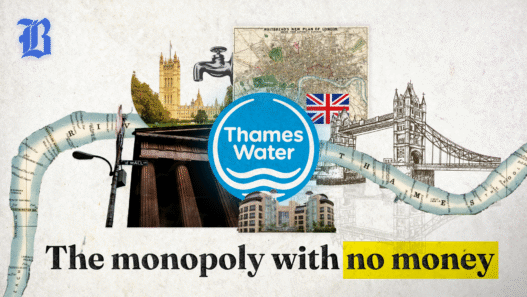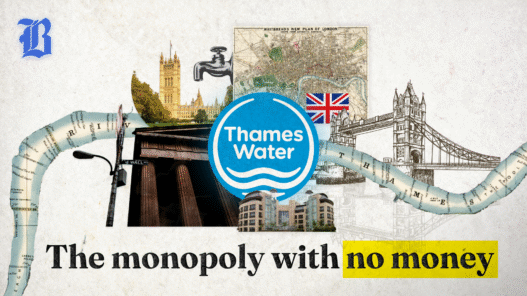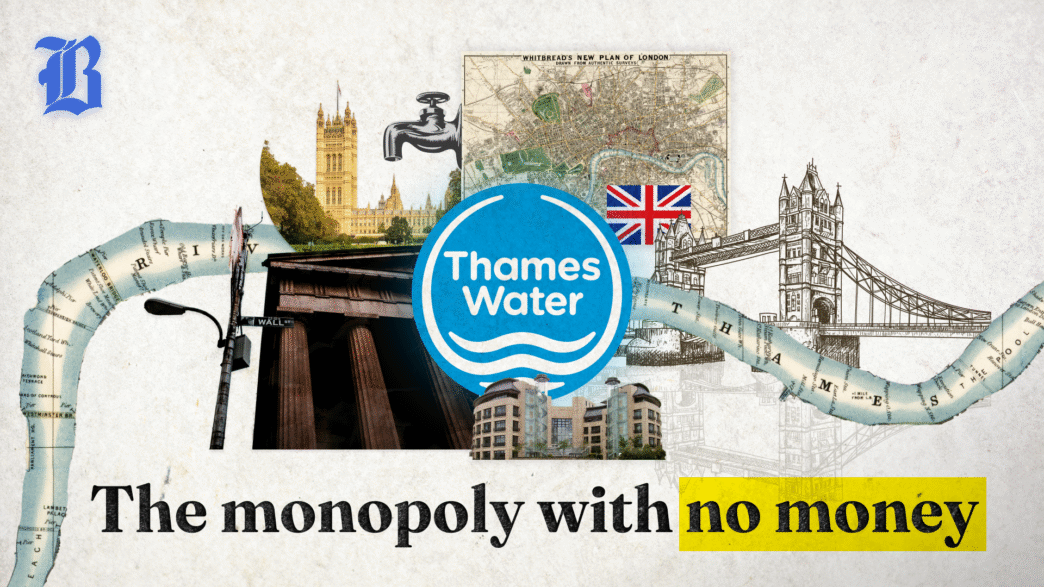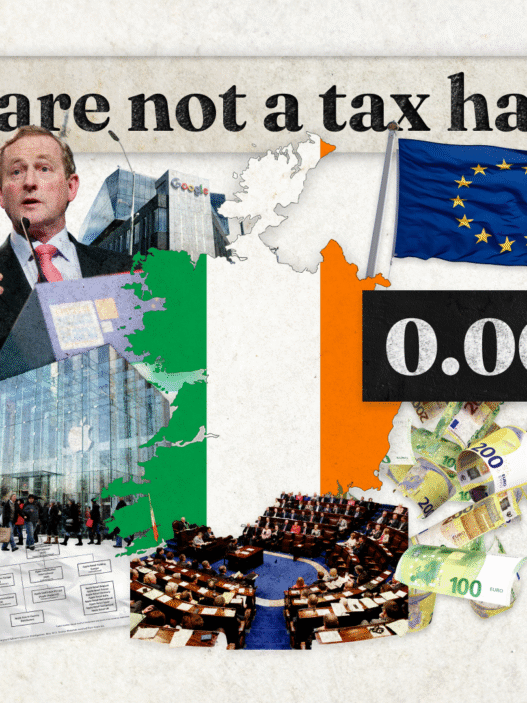Script
Turn on a tap in London and you’re paying Thames Water, a monopoly with 16 million guaranteed customers. Supplying a necessity should be stable and profitable, yet the firm is near collapse, weighed down by pollution fines, debt, and bonus scandals.
How is this happening while water bills are rising? To understand, we need to rewind to when England’s water industry was sold off. In the 70s and 80s England’s public water authorities struggled with a lack of funding and the worst pollution in Europe. So in 1989 Thatcher’s government privatised the water authorities in England and Wales, believing this would attract investment and improve efficiency. But if private companies were given free rein, prices would become extremely high, with no alternative for customers. So Ofwat, the water regulator, was created to enforce price caps and ensure responsible management.
Profitable water companies could then pay dividend yields of up to 4%, with outperforming firms allowed to pay even more. This was meant to deliver fair returns for shareholders, and incentivise greater efficiency. But some owners, in particular private equity and investment firms, have been accused of asset stripping – getting paid large dividends by decreasing infrastructure spending and increasing borrowing.
Often, dividends paid to shareholders were more than annual profits. This loaded the company with debt while pipes decayed, leading to leaks and river pollution. Thames Water now has £22bn in debt, which is 80% of its assets and over 8 times its £2.6bn annual revenue. Many of its private equity owners, who earned high returns, have already sold their shares. Australian investment bank Macquarie expressed pride in its ownership of Thames Water, despite the company’s debt tripling during its decade-long stake ending in 2017.
Thames Water blames Ofwat for the situation it’s in, and it’s not entirely wrong. The regulator sets the bill price caps based on how much investment it approves for water companies to carry out. For a long time, it kept water bills low, meaning less money for infrastructure like pipes, treatment plants and reservoirs. Ofwat has also allowed water company debt to spiral past its recommended limit of 55%.
Thames Water, the country’s most indebted water company, has also been hit by a wave of pollution fines, leading to an annual loss of £1.6bn in 2024 to 25. The firm needs money from somewhere, but the Ofwat price cap means it can only get so much from customers. Thames Water is demanding that the water bills rise and pollution fines be waived, but Ofwat is refusing.
And while the company is in turmoil, it has insisted on paying huge bonuses to senior management, including an almost £200k bonus to CEO Chris Weston, for just 3 months of work. It was accused of diverting cash for environmental work and clean-ups to pay for these bonuses, despite cash flow targets being missed. And even after pressure from ministers, the water company refused to claw back the extra remuneration, though it later paused future bonuses.
The future of Thames Water is uncertain. To stay afloat, it needs money from investors and lenders. But its precarious financial situation and lack of future dividend payments has earned it a label of being uninvestable. Recently, the private equity firm KKR pulled out of a rescue plan for the company, as it did not expect finances to improve in a reasonable time. Chris Weston admitted a turnaround would take at least a decade to complete.
The government has started preparing for it to fall into special administration, a temporary form of nationalisation. This would occur if the water company can’t pay its debts or maintain essential services. But with an estimated cost of £3.5 to £5bn for the taxpayer, other alternatives may be preferable. Thames Water’s senior creditors are seeking a rescue deal to avoid the steep debt write-downs triggered by special administration.
But if unsuccessful, the Hong Kong-based infrastructure firm CKI may acquire the company. It already owns Northumbrian Water and UK Power Networks. Some people have voiced concerns about allowing further foreign ownership of vital English infrastructure. But Thames Water and other English water companies are already owned by an array of foreign private equity, investment and pension funds. With the government reluctant to fund permanent nationalisation, CKI’s takeover currently appears the most likely outcome.
With protections in place, London residents don’t need to worry. When they turn on their taps, water will still come out. The more pressing question, however, is how much it will cost and who will pay to keep it this way.
References
Bayliss, K. (2022). Who Owns Our Water. [online] We Own It. Available at: https://weownit.org.uk/who-owns-our/water.
Clarke, M. (2025). Ofwat fines Thames Water nearly £123m following two investigations into the company – Ofwat. [online] Ofwat. Available at: https://www.ofwat.gov.uk/ofwat-fines-thames-water-nearly-123m-following-two-investigations-into-the-company/.
Discover Water UK (2024). DiscoverWater.co.uk. [online] Find out how water companies in England & Wales are performing. Available at: https://www.discoverwater.co.uk/annual-bill.
Gapper, J. (2025). Britain should come clean about its water industry. [online] @FinancialTimes. Available at: https://www.ft.com/content/41a31d34-523e-45b2-8c68-6349e376e01e [Accessed 11 Sep. 2025].
Horton, H. (2025a). Ofwat to be abolished in ‘reset’ of water industry regulation. [online] the Guardian. Available at: https://www.theguardian.com/business/2025/jul/21/new-powerful-water-regulator-to-replace-failed-ofwat-in-drive-to-reset-sector [Accessed 14 Aug. 2025].
Horton, H. (2025b). Thames Water: advisers appointed to plan for company’s potential collapse. [online] the Guardian. Available at: https://www.theguardian.com/business/2025/aug/12/thames-water-advisers-appointed-to-plan-for-utilitys-potential-collapse [Accessed 27 Aug. 2025].
Isaac, A. (2024). Revealed: Thames Water diverted ‘cash for clean-ups’ to help pay bonuses. [online] the Guardian. Available at: https://www.theguardian.com/business/2024/dec/23/revealed-thames-water-diverted-cash-for-clean-ups-to-help-pay-bonuses.
Jolly, J. (2025). Macquarie ‘very proud’ of Thames Water ownership despite loading it with debt. [online] the Guardian. Available at: https://www.theguardian.com/business/2025/apr/29/macquarie-thames-water-uk-debt.
Kelly, M., Smith, R., Pickard, J. and Healy, E. (2025). Thames Water expresses doubt it can avoid temporary nationalisation. [online] @FinancialTimes. Available at: https://www.ft.com/content/e896912d-bcc6-48dc-8653-c5006626b1bc.
Laville, S., Leach, A. and García, C.A. (2023). In charts: how privatisation drained Thames Water’s coffers. The Guardian. [online] 30 Jun. Available at: https://www.theguardian.com/business/2023/jun/30/in-charts-how-privatisation-drained-thames-waters-coffers.
Ofwat (1990). Water Service Companies. [online] Available at: https://www.ofwat.gov.uk/wp-content/uploads/2021/06/1989.pdf.
Ofwat (2024). Returns and dividends – Ofwat. [online] Ofwat. Available at: https://www.ofwat.gov.uk/households/your-water-company/returns-and-dividends/.
Osborne, A. (2025). Labour needs to pull the plug on Thames water torture. [online] Thetimes.com. Available at: http://thetimes.com/business-money/companies/article/labour-should-pull-the-plug-on-thames-water-now-js8lqvjmx [Accessed 28 Aug. 2025].
Pickard, J. (2025). Thames Water refuses to claw back bonuses despite government threats. [online] @FinancialTimes. Available at: https://www.ft.com/content/fc019bc9-133a-4627-9849-acc02336d6cf [Accessed 27 Aug. 2025].
Plimmer, G. and Hollowood, E. (2024). Water companies pay £2.5bn in dividends in two years as debt climbs by £8.2bn. [online] www.ft.com. Available at: https://www.ft.com/content/c3cdfefb-c912-4699-bb7f-72c5c6515757.
Pratley, N. (2024). Cheap sales, debt and foreign takeovers: how privatisation changed the water industry. [online] the Guardian. Available at: https://www.theguardian.com/business/article/2024/jul/10/cheap-sales-debt-and-foreign-takeovers-how-privatisation-changed-the-water-industry.
PWC (2025). Water Industry Special Administration Process. [online] Pwc.co.uk. Available at: https://www.pwc.co.uk/services/business-restructuring/insights/water-industry-special-administration-process.html [Accessed 12 Sep. 2025].
Race, M. (2025). Thames Water ‘extremely stressed’, warns boss amid huge losses. BBC News. [online] 15 Jul. Available at: https://www.bbc.co.uk/news/articles/czxw2edxen9o.
Smith, R. and Plimmer, G. (2025). Thames Water boss keeps bonus despite missing target after restatement. [online] @FinancialTimes. Available at: https://www.ft.com/content/8988ff8a-61d5-4a2f-9fdb-ca6c119da2b2.
Smith, R., Plimmer, G. and Healy, E. (2024). How Thames Water became a battleground for hedge funds. [online] @FinancialTimes. Available at: https://www.ft.com/content/508771ea-2d4f-420e-9631-4d9a1dcf8062.
Thames Water (2025). Thames Water Annual Report 2024/25 – Transforming for a resilient future. [online] Available at: https://www.thameswater.co.uk/media-library/l13deqmw/thames-water-annual-report-2024-25.pdf.
The Economist (2025a). Britain’s water watchdog is to be put down. [online] The Economist. Available at: https://www.economist.com/britain/2025/07/21/britains-water-watchdog-is-to-be-put-down [Accessed 27 Aug. 2025].
The Economist (2025b). Can Britain untangle the mess in its water industry? [online] The Economist. Available at: https://www.economist.com/britain/2025/06/05/can-britain-untangle-the-mess-in-its-water-industry.
Thomas, H. (2023). Water has a private equity, not a private ownership, issue. Financial Times. [online] 3 Jul. Available at: https://www.ft.com/content/ba0bc8df-e760-4cee-b291-21708be28c6f.
Wright, O. and Lea, R. (2025). Thames Water could be sold to a Chinese firm after public rescue. [online] Thetimes.com. Available at: https://www.thetimes.com/business-money/companies/article/thames-water-faces-government-administration-amid-financial-crisis-kfkhw5bdk [Accessed 27 Aug. 2025].
Media References
Creative Commons Photos
https://www.flickr.com/photos/brighton/4862267593/ https://commons.wikimedia.org/wiki/File:Margaret_Thatcher_cropped.jpg https://commons.wikimedia.org/wiki/File:British_Parliament_(14749841802).jpg https://commons.wikimedia.org/wiki/File:British_Parliament_%2814749841802%29.jpg
Non-CC Photos
https://www.pexels.com/photo/big-ben-in-london-england-seen-from-park-19736345/
https://www.pexels.com/photo/hongkong-night-skyline-16732092/
https://www.pexels.com/photo/hydroelectric-power-pipes-in-rodberg-norway-31502428/
https://www.pexels.com/photo/scenic-aerial-view-of-ladybower-reservoir-dam-28951511/
https://www.pexels.com/photo/buildings-with-glass-windows-351264/
https://www.pexels.com/photo/skyscrapers-on-sea-coast-in-sydney-20715706/
https://www.pexels.com/photo/river-thames-in-england-1637907/
https://www.pexels.com/photo/pipe-with-sewage-15954727/
https://www.pexels.com/photo/buildings-with-waterfront-view-1650882/
Videos
https://www.pexels.com/video/high-angle-footage-of-the-city-in-time-lapse-3652702/ https://www.pexels.com/video/video-of-cityscape-footage-from-dusk-til-dawn-3568720/ https://www.pexels.com/video/time-lapse-video-of-a-city-6823023/















